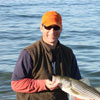The Importance of Fishing Licenses
By Tom Keer
Apr 10, 2014
From the time I was 16 I could predict that I would get a fishing license for Christmas. It was a guaranteed gift and it was one that probably took the sting out of some of the necessities that I disappointingly received (like socks). When the clock struck midnight on December 31st I was set-to-jet.
From the time I was 16 I could predict that I would get a fishing license for Christmas. It was a guaranteed gift and it was one that probably took the sting out of some of the necessities that I disappointingly received (like socks). When the clock struck midnight on December 31st I was set-to-jet.
Later on as an adult, my friends and I made a habit of going to the local tackle shop on January 2nd to buy our licenses. Since fishing licenses are required for our favorite activity, we made a ritual out of it. Our day usually started with breakfast at a local diner where we would talk about last year’s fishing, the upcoming season, and all of the rest of the stories that make fishing so much fun. When the shop opened at 10 AM we’d join the line of other like-minded anglers, work our way through the aisles of tackle and gear, and plan our next trip. Fun times indeed.
But there is much more to the simple fishing license than just receiving it as a gift or for starting out the New Year on the right foot. Fishing licenses are a way that anglers and boaters give back to their favorite natural places. You see, the fees from fishing licenses are a tremendous source of revenue for fish and game funds for most states to help preserve and enhance our waterways. For example:
A substantial amount of revenue goes towards stream, river, pond and lake stockings. In areas that are shy on fish species, state agencies add hatchery raised fish so anglers to have good-to-excellent fisheries.
A second significant program is the hiring of game officials to patrol spots to be sure that anglers are following the rules. Their objective is to be sure that all anglers are compliant with creel limits, length requirements, seasonality, and other regional laws. (They are there to be stewards of waterways, not to inhibit you from fishing.)
A third use of the funds is towards habitat programs. Some of the programs are aimed at clean ups, where litter and other debris are removed to create healthier waterways. In other areas they are used to create fish ladders to facilitate spawning or stream or lake restoration. Improving our habitat is critical, and every project counts.
A last, and to my mind a critical program is the promotion of fishing in a state. Some agencies generate public relations materials, sponsor youth fishing days and educational clinics, and promote the benefits of being outside. Anything we can do to create a solid legacy for our children and to get them outdoors gets my vote any day of the week and twice on Sunday. But you all know that already….And if you don’t already have your license, click here.
Later on as an adult, my friends and I made a habit of going to the local tackle shop on January 2nd to buy our licenses. Since fishing licenses are required for our favorite activity, we made a ritual out of it. Our day usually started with breakfast at a local diner where we would talk about last year’s fishing, the upcoming season, and all of the rest of the stories that make fishing so much fun. When the shop opened at 10 AM we’d join the line of other like-minded anglers, work our way through the aisles of tackle and gear, and plan our next trip. Fun times indeed.
But there is much more to the simple fishing license than just receiving it as a gift or for starting out the New Year on the right foot. Fishing licenses are a way that anglers and boaters give back to their favorite natural places. You see, the fees from fishing licenses are a tremendous source of revenue for fish and game funds for most states to help preserve and enhance our waterways. For example:
A substantial amount of revenue goes towards stream, river, pond and lake stockings. In areas that are shy on fish species, state agencies add hatchery raised fish so anglers to have good-to-excellent fisheries.
A second significant program is the hiring of game officials to patrol spots to be sure that anglers are following the rules. Their objective is to be sure that all anglers are compliant with creel limits, length requirements, seasonality, and other regional laws. (They are there to be stewards of waterways, not to inhibit you from fishing.)
A third use of the funds is towards habitat programs. Some of the programs are aimed at clean ups, where litter and other debris are removed to create healthier waterways. In other areas they are used to create fish ladders to facilitate spawning or stream or lake restoration. Improving our habitat is critical, and every project counts.
A last, and to my mind a critical program is the promotion of fishing in a state. Some agencies generate public relations materials, sponsor youth fishing days and educational clinics, and promote the benefits of being outside. Anything we can do to create a solid legacy for our children and to get them outdoors gets my vote any day of the week and twice on Sunday. But you all know that already….And if you don’t already have your license, click here.
Popular Posts









